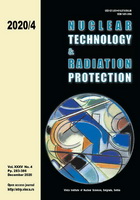
A MODELED RADIOLOGICAL DISPERSIVE DEVICE RELEASE AND THE IMPACT TO DECISION-MAKING IN AN URBAN ENVIRONMENT

Vol.
XXXV, No. 4, Pp. 283-386
December 2020
UDC 621.039+614.876:504.06
ISSN 1451-3994
Pages: 316-322
Authors: Paulo U. N. Oliveira, Ubiratan C. Oliveira, Ricardo M. Stenders, Ademir X. Silva, Helio C. Vital, Matjaž Prah, and Edson R. AndradeAbstract
A radiological dispersion device is a weapon that combines radioactive material with conventional explosives for spreading radioactive material across an inhabited area. This study is focused on evaluating key parameters in an radiological dispersion device scenario. The calculations were performed to include two different situations: by using explosives and by simple mechanical release. Simulations were conducted with the use of the HotSpot Health Physics Codes. The results suggest the existence of significant correlations between stability classes in scenarios where they evolve with time, producing alternations between them. As long as the stability class remains constant, this latter finding offers the possibility of creating a suitable response, based on temporal evolutions. Therefore, the purpose of this study is to: estimate the size of the potentially affected population, estimate absorbed doses, and estimate the cost-effectiveness in order to help initial responses by providing time-sensitive information about the event. A methodology capable of providing useful information allows prompt decisions and initial assessments of future risks to be made efficiently. This approach can also provide a training environment for the personnel responsible for the decision-making at an early stage of the response.
Key words: atmospheric dispersion, contamination, radiation, cost-effectiveness
FULL PAPER IN PDF FORMAT (597 KB)